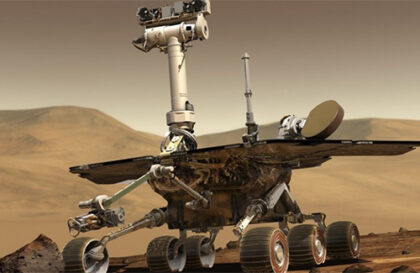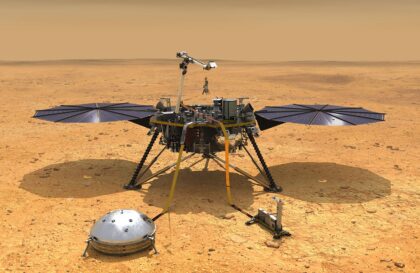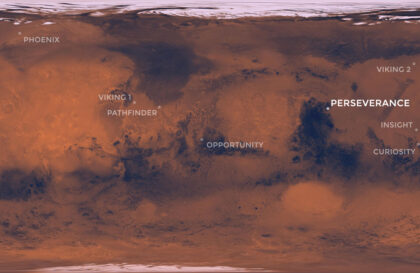In September 2017, the Sun experienced a series of powerful flares, including one of the most powerful – class X8.2. These flares caused changes in auroras on Earth and problems with communications.
According to NASA’s Solar Dynamics Observatory, the Sept. 10 flare released 82,000 times the sun’s average X-rays in a short, concentrated burst. This type of “extreme” flare occurs less than ten times during a single solar cycle.
In this time-lapse video, the 10 September 2017 X8.2 class solar flare extends from the right-hand side of the Sun’s surface near the equator. Because the flare originated from the edge of the Sun’s disk with respect to Earth, it was simultaneously visible from Mars. Credit: NASA/GSFC/SDO
Measurements taken by a spacecraft orbiting Mars showed heating and chemical changes in the planet’s atmosphere following this violent solar eruption.
On Mars, observations have shown that its upper atmosphere is heated unevenly due to these flares. As a result, the upper two layers of the atmosphere, the thermosphere, and ionosphere, responded to the flare by accelerating the loss of molecular oxygen into space.
Mars previously had a denser atmosphere with more oxygen. How and why this atmosphere is depleted has long been the focus of scientists in the search for life on Mars.
New evidence suggests that multiple strong solar flares throughout Mars’ history may have influenced its atmosphere. Edward Thiemann of the University of Colorado believes that studying the influence of these flares can help understand the evolution of the atmosphere of Mars and the habitability of exoplanets around active stars. The research was published in Geophysical Research Letters and presented at the Earth-Sun Summit in Virginia.
Why is oxygen measured?
In ancient times, Mars had a thick atmosphere, allowing liquid water to flow across its surface. However, most of this atmosphere disappeared over time, turning the planet into a cold desert. NASA research, including the MAVEN and Curiosity missions, supports this theory.
Studying the isotopic composition of oxygen in the atmosphere of Mars may provide a unique opportunity to understand its past. This approach is based on the principle that light isotopes volatilize faster than their heavier counterparts. Thus, the planet’s atmosphere will become enriched over time in heavier isotopes. This process partly explains why modern Mars is rich in the isotope 18 O, compared to the lighter 16 O, which is dominant on Earth.
From this knowledge, scientists can infer the amount of atmosphere Mars has lost over time. By comparing oxygen isotope ratios on Mars and Earth, researchers can understand what Mars was like in the past and estimate the volume of its original atmosphere. Although this method contains certain assumptions, it provides valuable information about the climate history of the Red Planet and helps understand the reasons for its current state.
NASA MAVEN satellite measurements
Credit: NASA’s Goddard Space Flight Center
Researchers used NASA’s MAVEN satellite data to study how Mars’ atmosphere reacts to intense solar flares. MAVEN, orbiting Mars, looks at its upper atmosphere and the effects of the solar wind. After arriving on Mars in 2014, it made the first direct measurements of the impact of solar activity on another planet. But given the decreasing activity of the Sun in the current cycle, scientists believed that repeated measures were unlikely.
However, September 2017 brought a surprise. The strong flares came as a surprise to the MAVEN team. Fortuitously, MAVEN’s orbit brought it within 155 km of Mars just 80 minutes after the flare’s peak, allowing direct measurements of the ionospheric and thermosphere response to the X-class flare. The satellite measured the parameters of the upper atmosphere. Tiemann emphasized that if observations were made from the night side, the reaction of the atmosphere would go unnoticed.
MAVEN data showed that solar radiation led to a reaction in the upper atmosphere of Mars. Tiemann pointed out that the thermosphere of Mars has become very hot, causing it to expand and interact with the ionosphere. This led to changes in O2 and CO2 concentrations, accelerating the ionization of oxygen and increasing its loss to space by 50% above normal. Tiemann stressed that future research should consider the thermosphere and ionosphere as interconnected systems.
Credit: NASA/GSFC
Since the basis of Mars’ atmosphere is carbon dioxide (CO2), the researchers studied the oxygen isotopes associated with the carbon atoms in CO2. To study the Martian atmosphere, the team used NASA’s Infrared Telescope located on Mauna Kea, Hawaii, using the Heterodyne Planetary Wind and Composition Instrument built at NASA Goddard Laboratories.
Mendillo, an astronomy professor at the University of Colorado, said the new data is necessary because previous studies relied on observations of the Sun from Earth. He highlighted the uniqueness of MAVEN, which is continuously switched on, making it the first satellite to record flare conditions directly on Mars. Mendillo described the results as “impressive” and noted the interest in space weather not only on Earth, but also on other planets.
Banner image: NASA’s Goddard Space Flight Center
Image credit:
https://www.nasa.gov
https://eos.org
https://www.nasa.gov
https://www.space.comt






